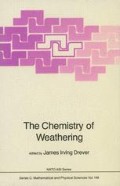Abstract
Iron oxides are among the most common minerals formed during rock weathering. They vary in mineral species (goethite, hematite, lepidocrocite, maghemite, ferrihydrite) and, additionally for any mineral, in crystallinity and Al- for Fe-substitution in the structure. All three parameters may reflect the weathering environment. For example, the ratio of goethite to hematite, which is the most important pair of Fe oxides, varies widely with climatic conditions (as caused by latitude and altitude), with topographic position in a landscape, and with profile depth. This can be partly explained by such factors as soil temperature, moisture, organic matter and pH. A kinetic model based on synthesis experiments is proposed, according to which goethite may be formed from various Fe sources via a solution-nucleation-crystallization process, whereas hematite is formed from ferrihydrite via a dehydration-rearrangement process within the defect hematite-like structure of ferrihydrite. These two processes are competitive. Their relative rate depends on the environmental conditions and determines the final goethite/hematite ratio. This kinetic concept is preferred over a thermodynamic stability concept with which, because of kinetic hindrance, experimental results are often in disagreement.
The precursor of hematite — ferrihydrite — often occurs in weathering environments and can usually be considered a young metastable Fe oxide of low structural order and high surface area. Its transformation to more stable forms may be considerably retarded by adsorbed silicate and organics.
Environmental effects can also influence the formation of lepidocrocite and maghemite.
In routine X-ray diffraction, line widths are often related to the crystallinity of fine grained minerals. Line broadening was shown to originate mainly from small crystal size rather than from structural disorder, and may vary considerably for any one Fe oxide, goethite. It may therefore reflect the conditions of crystallization in the weathering environment.
This is also the case for Al- for Fe-substitution in the Fe oxide structure, which again varies with the environment depending on such factors as Al activity in solution, and also on the type of the Al species.
Following these results, an intensivated use of Fe oxides in the weathering zone as indicators of the weathering environment is advocated.
A detailed report on this subject will be puvlished in “Advances in Soil Science” Vol. 1, 1984.
Access this chapter
Tax calculation will be finalised at checkout
Purchases are for personal use only
Author information
Authors and Affiliations
Editor information
Editors and Affiliations
Rights and permissions
Copyright information
© 1985 D. Reidel Publishing Company
About this chapter
Cite this chapter
Schwertmann, U. (1985). Formation of Secondary Iron Oxides in Various Environments. In: Drever, J.I. (eds) The Chemistry of Weathering. Nato ASI Series, vol 149. Springer, Dordrecht. https://doi.org/10.1007/978-94-009-5333-8_7
Download citation
DOI: https://doi.org/10.1007/978-94-009-5333-8_7
Publisher Name: Springer, Dordrecht
Print ISBN: 978-94-010-8855-8
Online ISBN: 978-94-009-5333-8
eBook Packages: Springer Book Archive

